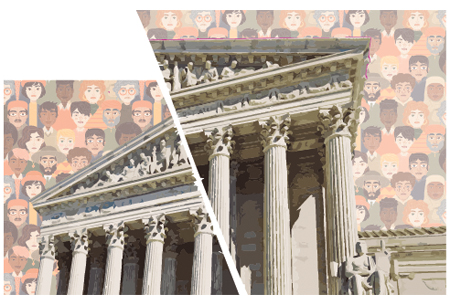Letters from Readers

Arts institutions should embrace work of hyphenated artists
This letter comes to express how much I have enjoyed and learned from the extremely well-written and informative article in the June issue (“Cover Story: More than Just Ethnic Artists”). One of our most important missions as a local nonprofit community arts center is to ensure that we represent all residents of our unique highly diverse community. Johns Creek is fortunate that we are a very vibrant, culturally diverse community with a significant Indian American population. We want very much to be inclusive and sensitive in our programming and serve the local Indian community that has been one of our most active and loyal supporters. Articles such as those mentioned in the Khabar story, as well as personal interactions with leaders of the Indian American community, are very enlightening and useful in educating us about cultural traditions and practices within this community.
Far too often, as Indian American artist Mahimtura Folsbee points out, artists from a diasporic background are expected to make work specifically about their culture of origin which can be limited and stultifying. There is often little understanding or appreciation for artwork that is not specifically ethnic. This is a concern shared by many hyphenated American artists and one that must be addressed by arts institutions as these artists seek to enter the mainstream art world. This is particularly true of generations of younger artists, many of whom grew up and were educated in both the traditions of their native as well as adopted cultures. While there will always be a treasured space for artists working in traditional Indian art forms, it is equally important that artists are not pigeonholed and discouraged from pursuing personal, more individualized goals in their art.
Beyond Borders, one of our most significant upcoming exhibitions in 2024, will include many of the Indian American artists living in the metro Atlanta area. I hope that this article will be helpful in identifying artists and ensuring that each artist has an opportunity to share their own unique vision as an artist—a vision informed by both their Indian and American experiences.
Althea Foster
Curator/Program Director Johns Creek Arts Center, GA
Is affirmative action the right solution?
Kudos to the excellent article by Neera K. Sohoni in the August issue (“Commentary: Straddling the Fine Line on Racial Equity”) on the recent Supreme Court ruling on affirmative action. I agree there is a need to redress wrongs of past discrimination, and that schools have a right to create leaders that benefit society from all walks of life irrespective of color, caste, demographics, etc.—and that the benefits of developing a base of such leaders will lead to greater productivity, innovation, and cultural competency in the long term. I also agree that schools have the right to ensure that they are more representative of the populations they serve with diverse opinions. I understand that some studies indicate that affirmative action results in an increase in the number of underrepresented minority students.
But consider the other side of the table. You cannot assign responsibility to the people of today for the harms of the past. You cannot impose the cost of remedy on people today who have not contributed to the harms of the past. If you want the best in the class, you need to look to the market to bring equity and results. As an example: in college athletics, only performance matters. In music and arts, performance matters. Why not college admissions?
In mandating quotas, you begin an artificial mismatch of ability which can engender failure and high dropout rates for students. As an example, some studies indicate that about half of Black college students rank in the bottom 20 percent of their classes. Outcomes are worse for elite colleges. There are also unintended consequences of self-attesting to race. Only one-third of the Black admissions are American Blacks, with the rest being from Brazil, Nigeria, and Botswana, to name a few nations. That’s the unintended consequence of the race-based admission construct.

Another unintended result is the reinforcement of stereotypes. Quotas reinforce stereotypes by suggesting that individuals from certain groups are not capable of competing on an equal footing with others. This can lead to stigmatization and discrimination against those who are targeted by such a policy. Yet another example of unintended consequence is that race-based admissions can create resentment among individuals who feel that they have been unfairly disadvantaged by the policies. This can lead to social tensions and conflicts between different groups.
Another consequence is lowering standards. In some cases, this policy leads to a lowering of standards in order to meet the required admissions. This can result in a decline in the quality of education or job performance and can have negative consequences for overall productivity and competitiveness. Race-based admissions neglect other disadvantaged groups, such as women or individuals with disabilities, who may also face barriers to equal opportunity.
Finally, while we are on this topic, we also need to address the notion that race-based admissions are in society’s best interest—and I use the example of medical schools. This involves the notion that adversity and measures of adversity should be a component of medical school admissions due to a belief that physicians who have overcome some adversity will produce better healthcare outcomes when, in fact, this belief ignores the best interests of patients.
So, what are better ways to help the marginalized and deliver equity? Examples of such better ways are to admit the top 10 percent of a high school’s graduating class into a college. Or improve outreach in impoverished and marginalized areas. Or over-index federal funding and financial aid for marginalized people on a go-forward basis.
In closing, we must ask the question: what is real diversity? Real diversity considers skill set, education, work experiences, cultural orientation, commitment, enthusiasm, motivation, sociology, economic status, and potential—not race and country of origin. It is what makes both schools and nations strong and resilient.
Sonu Mirchandani
Entrepreneurship Program Director
College of Business and Technology
East Tennessee State University
What if the word “marriage” is not used?
I read the thought-provoking article “India’s Judicial Conundrum” (June 2023 issue) by N. K. Sohoni with great interest. What will happen if the word “marriage” is not used at all to define a union of two persons, regardless of whether the two persons are heterosexual or LGBTQ+? If two persons of any sexual orientation want to unite as a couple, they can make a legal agreement for property rights, child custody, etc. (if applicable). This may be a radical idea resulting in drastic changes: it abandons the very meaning of marriage as we know it. But it would eliminate completely the complications involving courts, legislatures, or religious organizations.
Thank you for providing the opportunity to speak out my thoughts.
P. Swamy
Greenville, SC
Interested in writing for Khabar?
Writers are invited to contact us at editor@khabar.com for submission guidelines. Please include links and/or attach copies of published articles, if any, as samples of your work. A review of our back issues online will give you a good idea of what we like to publish. Pitches or unsolicited articles that haven’t appeared elsewhere are welcome as well. If there is further interest, Khabar will respond with an offer or provide more information on our requirements.
What’s on YOUR mind?
We welcome original, unpublished letters from our readers. You could either respond to a specific article in Khabar or write about issues relevant to our community. Letters may be edited for length and other considerations. Longer submissions by readers may be considered for the “My Turn” column.
Email: letters@khabar.com • Fax: (770) 234-6115.
Mail: Khabar, Inc. 3635 Savannah Place Dr, Suite 400, Duluth, GA 30096.
Note: Views expressed in the Letters section do not necessarily represent those of the publication.
Enjoyed reading Khabar magazine? Subscribe to Khabar and get a full digital copy of this Indian-American community magazine.
blog comments powered by Disqus










